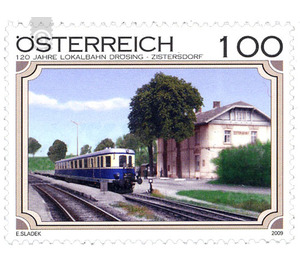railroad - Austria / II. Republic of Austria 2009 - 100 Euro Cent
Theme: Traffic, Transportation & Mobility
| Country | Austria / II. Republic of Austria |
| Issue Date | 2009 |
| Face Value | 100.00 |
| Edition Issued | 400,000 |
| Printing Type | offset |
| Stamp Type | Commemorative |
| Item Type | Stamp |
| Chronological Issue Number | 2169 |
| Chronological Chapter | OOS-OE2 |
| SID | 608444 |
| In 66 Wishlists | |
The local railway Drösing - Zistersdorf is a branch line in Lower Austria, which until today, mainly due to the significant freight traffic, was spared from the setting. It branches off at Drösing from the northern railway in the direction of Zistersdorf, where there was connection to the former Stammersdorf local train to Dobermannsdorf on the one hand, on Bad Pirawarth and Groß Schweinbarth to Stammersdorf on the other. In 1886, the Emperor Ferdinand Nordbahn received a new concession, which obliged the railway company to build and operate several other local railways. Just three years later, on October 1, 1889, the line from Drösing via Ringelsdorf, Niederabsdorf and Eichhorn to Zistersdorf was opened. After the Emperor Ferdinand Nordbahn was nationalized in 1906, the k. k. Austrian state railway the operation of this branch line. The most prominent locomotives on this 11.736 km long route network were mainly steam locomotives of the class 93 and old diesel locomotives - on the mark is a railcar of the series 5042 shown in Zistersdorf station - later took over in particular 5047 diesel railcar passenger transport and diesel locomotives of the 2048 series freight transport. In addition to passenger transport, the railway served in the early years, especially the brickworks in Ringelsdorf and Niederabsdorf. In autumn, there were extensive beet transports. Due to the oil production in the area Zistersdorf it came from the 30s of the last century to significant oil transports. Although the railway had survived the decommissioning wave in 1988, it came on June 9, 2001 to stop passenger traffic. From this point on, there were only minor shipments of goods - until the construction of the waste incineration plant Zistersdorf, for which even the superstructure of the railway line was completely renewed in 2009 in order to maintain a higher category. At present it is being negotiated whether passenger traffic should also be resumed.


